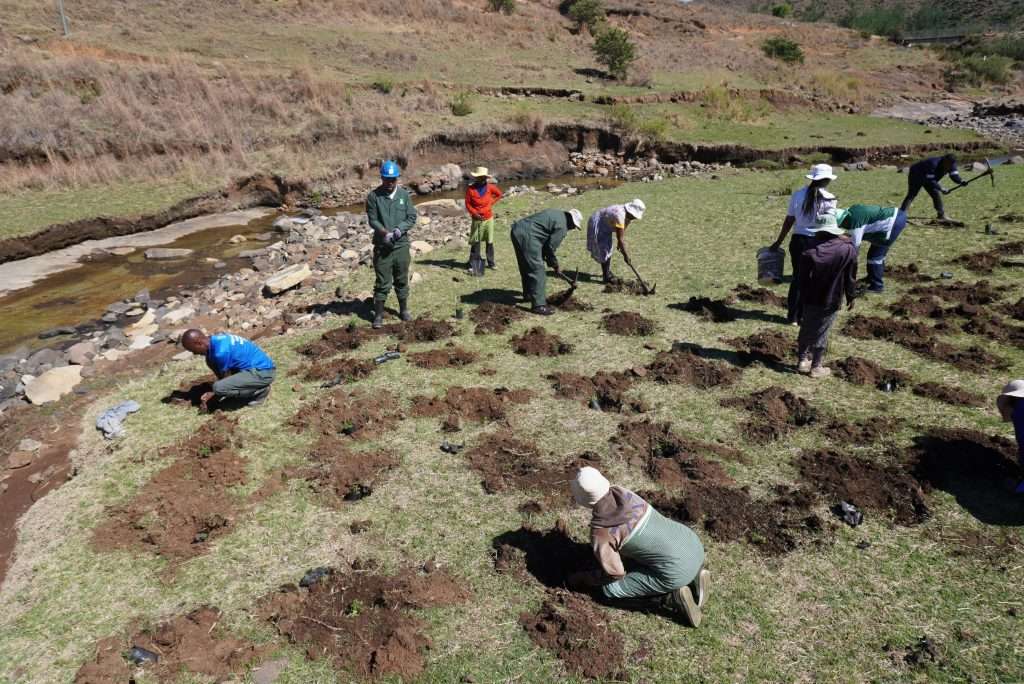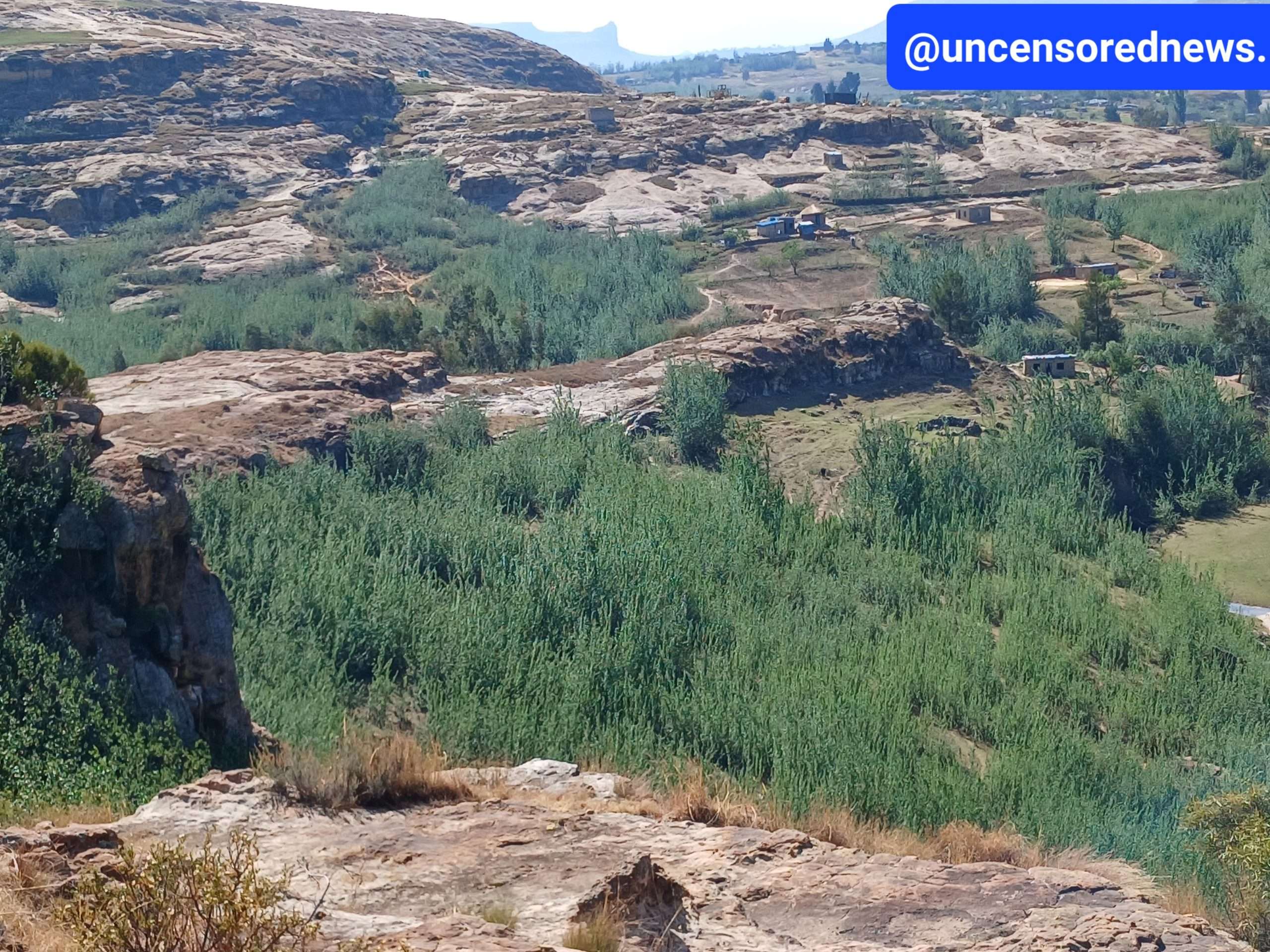Reforesting Upstream of ‘Muela Dam: A Natural Solution to Combat Soil Erosion and Preserve Water Levels
Soil erosion in ‘Muela underscores a larger issue – the critical problem of land degradation that Lesotho is addressing. In the era of climate change, there is an urgent need for coordinated efforts to mitigate harmful human activities that significantly contribute to land degradation, which poses a major threat to the country’s natural resources.
7 November 2023 by Lucia Moshoeshoe

In ‘Muela, the LHDA celebrated its 37th anniversary by planting trees. Credit: Lucia Moshoeshoe.
In the picturesque village of Boinyatso, nestled within the breathtaking highlands of Botha-Bothe in Lesotho, a momentous celebration is underway as the Lesotho Highlands Development Authority (LHDA) marks its 37th anniversary.
LHDA’s ‘Muela branch has gathered beneath the boundless azure sky to reflect on its 37-year journey and renew its unwavering commitment to the land that has been their home for generations.
The central focus of 24 October’s celebration is the planting of 367 trees upstream of the ‘Muela Dam.
“We have observed significant soil erosion in ‘Muela,” ‘Muela Branch Manager Lehlohonolo Molapo stated.
Soil erosion is typically characterised by three processes of “soil loosening, transport, and deposition.” According to study that focused on China, these processes often lead to the relocation of topsoil.
In the case of Lesotho, Molapo explains that the eroded soil ends up in the ‘Muela Dam, and the excessive build-up of sediment in the dam could potentially impact water levels.
The ‘Muela Hydropower Station is part of Phase I of the multi-phased Lesotho Highlands Water Project (LHWP) between Lesotho and South Africa. The project aims to provide water to South Africa’s economic hub of Gauteng and generate hydroelectricity for Lesotho, as stipulated in the 1986 Treaty.
To date, Lesotho has earned M14.9 billion in water royalties, transferring 18,661.9 million cubic meters of water between 1998 and August 2023, according to LHDA. However, the hydropower station has faced challenges, including ageing transformers and recurrent sludge incidents in the ‘Muela Dam.
Challenges at ‘Muela
Unit I of the three electricity units at ‘Muela Power Station failed to restart due to critical components reaching the end of their service life in June 2022, leading to the shutdown of all three units because they are approaching the end of their service life.
Molapo highlights the need for frequent maintenance and eventual replacement of agieng generators.
In 2017, during a tour of ‘Muela Power Station by former Water Minister Kimetso Mathaba, LHDA’s Reentseng Molapo warned the Lesotho government about addressing the station’s challenges.
At the time, Lesotho Times quoted Reentseng as saying, “The hydropower station was built in 1996, with the last machinery purchased in 1998. As a result, our annual machinery repair expenses have been escalating each year.”
Reentseng emphasised the need to replace the Katse-Mohale tunnel bypass valve, saying the LHDA parted with M25.4 million for system repairs between 2008 and 2015.
While it’s not immediately clear whether the government acted on LHDA’s 2017 advice to allocate funding for system overhaul at ‘Muela, the warning became a reality in June 2022 when Unit 1 failed to restart due to a fault, causing the shut-down of all three units.
The unit was fully repaired a year later, and LHDA’s CEO, Tente Tente, acknowledged the lessons learned from this experience.
“An invaluable experience has been gained, and there are lots of lessons learned to be shared with the hydropower fraternity.”
Another significant challenge facing ‘Muela is excessive sludge in the reservoir, caused by soil erosion upstream of the dam. The sludge problem dates back to 2017 due to land degradation at the top of the dam.
“To address excessive sludge, we recognise the need to protect the soil around our dams, thus the tree planting initiative,” Molapo stated.
Tree and other forms of vegetation help control soil erosion. “Vegetation controls soil erosion by means of its canopy, roots, and litter components,” highlights a 2010 study on the impact of vegetative cover on different land uses.
However, the tree-planting initiative goes beyond erosion prevention. According to Molapo, these trees are expected to serve as a valuable source of firewood for the local community, providing a sustainable and eco-friendly solution for their heating and cooking needs.
Molapo also emphasised the close connection between land degradation and the persistent problem of soil erosion surrounding the Lesotho dams, exacerbated by the inflow of soil from the Katse Dam and the proximity of neighbouring villages.
Meanwhile, Boinyatso Chief Mohato Qhobela highlights the role of burning rangelands in contributing to soil erosion in the area. Qhobela states that the LHDA has taken proactive measures to educate the communities around ‘Muela on ways to care for the environment.
Soil erosion is a complex, overarching issue
Authors of a research study titled Accounting for land cover changes and degradation in the Katse and Mohale Dam catchments of the Lesotho Highlands note the challenges in developing countries like Lesotho to meet global requirements for reporting on degraded land, assessing degradation trajectories, and preserving natural capital.
The study, published in March 2021, indicates that “land degradation poses a major threat to the Kingdom’s natural assets.”
The difficulty in measuring and assessing land condition is one of the main reasons for this, as highlighted in the research, which investigated changes in land cover and condition from 1991 to 2013, using Landsat imagery.
The study reveals significant reductions in the Normalized Difference Vegetation Index (NDVI) in both the Katse and Mohale dam catchments from 1991 to 2013, with an accelerated rate of reduction after the dams were constructed. Just like ‘Muela, both Katse and Mohale dams were built under Phase I of the Lesotho Highlands Water Project.
“Given that the opposite trend was observed in nearby protected areas (Bokong and Ts’ehlanyane), this suggests that the observed trend (vegetation reduction) was more likely attributable to human activities within the dam catchments than to exogenous influences, such as climate change.
“This concurs with the findings of De Jong et al. (2013), who provide evidence of widespread degradation in parts of southern Africa, including Lesotho, that is not climate-induced. Indeed, estimates of stocking rates suggest that the rangelands in Lesotho could be overstocked by 40–80% (MFLR 2014), or even as much as 300% in some areas (Marake et al. 1998),” read the study.
A land cover analysis, according to the researchers, added further insight on the extent of degradation by identifying areas of bush encroachment, particularly in the mid-altitudes of the catchment areas.
“Indigenous woody vegetation had increased considerably in both catchments. The evergreen tree Leucosidea sericea, known as ‘ouhout’, is an important source of fuel and indigenous medicine. Normally associated with river courses, Leucosidea forms dense thickets on overgrazed and disturbed areas, and can become an aggressive invader.
“These findings suggest that overgrazing is leading to a denudation of the high-altitude grasslands and bush encroachment in the mid-altitude grasslands,” reads the report.
Unless this trend is reversed, researchers note, there could be significant consequences not only for the dams’ capacity to supply water to the region but also for the area’s ability to support the pastoral livelihoods that are the backbone of Basotho culture and tradition.
To combat land degradation not only in Katse, Mohale, and ‘Muela, institutions like LHDA and ReNOKA are collaborating with communities, scientists, and rangelands associations to rehabilitate Lesotho’s ecosystems.


